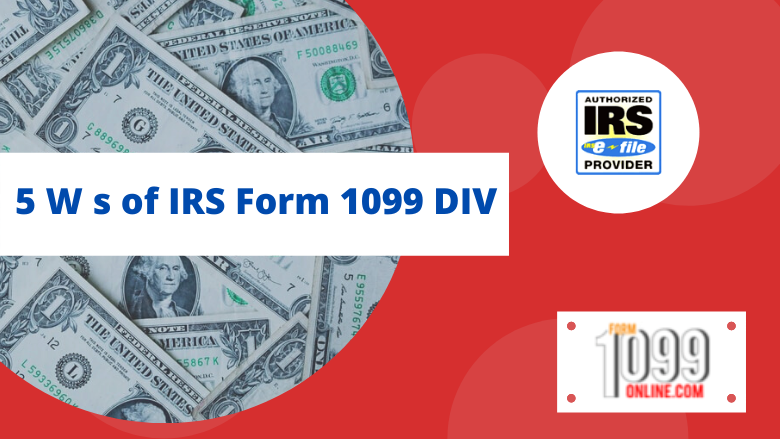Are you choosing to invest in mutual funds? Then you’ll receive income in the form of dividends throughout the tax year. Along with the income, you’ll receive Form 1099 DIV at the year-end by the mutual fund organization.
Getting confused? Don’t worry! We will let you know about IRS Form 1099 DIV. As many investors choose to invest in dividend-bearing stocks and earn dividends on a long-term basis. The financial institution, banks, or mutual funds organization that pay dividends exceeding $10 in a tax year sends 1099 DIV to the investors. Individuals who earned dividend income must report the dividends received on the tax return form.
Table of Contents
- What is 1099 DIV?
- When to use DIV?
- What a DIV tells us?
- What is a Dividend?
- What are the different types of dividends reported on 1099 DIV?

What is 1099 DIV?
IRS 1099 is the information return form that shows how much income you have paid/received apart from regular salary and wages. As we know there are numerous 1099 forms not only used to report dividends but also retirement distributions, lottery winnings, interest, etc.
Specifically, 1099 DIV used to report dividends paid to the individuals each tax year to the IRS. Mostly, banks, credit unions, mutual funds, and other financial distributions paid dividends paid to the shareholder every calendar year. So, if you paid $10 or more in the prior year i.e., 2020, then you need to report it on the 1099 Form to the IRS and the shareholder. Shareholders are not required to file this tax form along with tax returns. Instead, they must report the income information on the tax returns annually.
When to use DIV?
Unless the dividends paid to an individual exceed $10, you will not use Form 1099 DIV. Or else, if the financial institution pays an individual a dividend of $600 or more in a tax year, then they report the income paid on 1099 DIV. Payments made below the reporting threshold are not reported on the information return form. On the other hand, individuals who received income less than $10 or $600 from any entity, must report the income on their tax return. In other words, track the records of how much you earned in case you didn’t receive a 1099 DIV Tax Form.
What a DIV tells us?
Follow information is reported on an IRS 1099 DIV Form:
Box 1 a
Dividends paid for stocks, mutual funds, and exchange-traded funds are reported on box 1a of the form.
Box 1 b
The amount paid to an individual in the form of qualified dividends is reported on box 1b of the form.
Box 2a
Distributions paid by mutual funds, exchange-traded funds are reported on box 2a. Make sure that don’t report the distributions paid for individual stocks on this box.
Box 3
Include non-dividends distributions made by the organization to the individuals in box 3.
Box 5
Record Section 199A dividends on box 5. This includes dividends paid for the domestic real estate investment trusts.
Box 7
List the amount of foreign tax paid on box 7 of the form.
Boxes 11 & 12
Report the income paid in the form of tax-exempt interests on box 11. Box 12 consists of the portion of box 11.
What is a Dividend?
Most of the public traded businesses reinvest the profits to grow the business and raise the share prices. Among the profits earned, they pay some of their profits to shareholders as “dividends”. Hence, dividends are a portion of a firm’s net income that they don’t need for the growth of the business. These are distributed to the shareholder throughout the tax year in regular intervals. Moreover, the income that remained after paying out dividends is retained by the firm for the growth of the business. The business that pays dividends to the shareholder must report the income on the 1099 DIV Form to the IRS.
What are the different types of dividends reported on 1099 DIV?
There are three main types of dividends reported on Form 1099 DIV and each type has its tax implications:
Ordinary dividends
The dividends paid out from an organization’s profits are considered ordinary dividends. These are also called “non-qualified dividends”. Report the dividends paid from earnings or profits of an organization on box 1a of 1099 DIV.
Qualified dividends
Dividends paid by US corporations when the holding period of the underlying stocks met considered as “Qualified dividends”. Report the qualified dividends on box 1b of Form 1099 DIV.
Capital gain dividends
Dividends paid from dividend-paying stocks by mutual funds organizations are considered “Capital gain dividends”. Report the capital gain dividends on box 2a on Federal 1099 DIV.
Finally! Ready to file Form 1099s Online? Then choose Form1099Online. We are the IRS-trusted e-file provider site. Resolve to file time queries anywhere and at any time with our US-based support team. We provide customer support 24*7*365 through live chat, email, as well as phone support.
